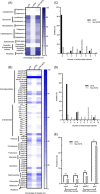Genomic investigation and nationwide tracking of pediatric invasive nontyphoidal Salmonella in China
- PMID: 38827503
- PMCID: PMC11139200
- DOI: 10.1002/mlf2.12117
Genomic investigation and nationwide tracking of pediatric invasive nontyphoidal Salmonella in China
Abstract
Invasive nontyphoidal Salmonella (iNTS) causes significant concern with ~15% morbidity, affecting populations mainly in African countries. However, iNTS infections among the Chinese pediatric population remain largely unknown. Here, we conducted a genomic investigation to study pediatric iNTS infections in a Chinese hospital. iNTS isolates accounted for 15.2% (18/119) of all nontyphoidal Salmonella (NTS) strains. Compared to non-iNTS isolates, iNTS isolates harbored a lower prevalence of antimicrobial-resistant genes of fluoroquinolones and β-lactams, as well as disinfectant determinants and plasmids, but carried a significantly higher prevalence of cdtB, faeCDE, and tcpC genes. Importantly, we detected an emerging serovar Goldcoast as the predominant iNTS serovar locally. By integrating 320 global Goldcoast genomes based on the One Health samplings, we conducted nationwide phylogenomic tracking and detected repeated human-to-human transmission events among iNTS cases caused by an underestimated serovar Goldcoast. Together, our exploratory genomic approach highlights a new trend in pediatric iNTS infections.
© 2024 The Authors. mLife published by John Wiley & Sons Australia, Ltd on behalf of Institute of Microbiology, Chinese Academy of Sciences.
Conflict of interest statement
The authors declare no conflict of interests.
Figures

Similar articles
-
Antimicrobial Resistance and Mechanisms of Azithromycin Resistance in Nontyphoidal Salmonella Isolates in Taiwan, 2017 to 2018.Microbiol Spectr. 2023 Feb 14;11(1):e0336422. doi: 10.1128/spectrum.03364-22. Epub 2023 Jan 23. Microbiol Spectr. 2023. PMID: 36688703 Free PMC article.
-
Nontyphoidal salmonella disease: Current status of vaccine research and development.Vaccine. 2016 Jun 3;34(26):2907-2910. doi: 10.1016/j.vaccine.2016.03.072. Epub 2016 Mar 29. Vaccine. 2016. PMID: 27032517
-
A nontyphoidal Salmonella serovar domestication accompanying enhanced niche adaptation.EMBO Mol Med. 2022 Nov 8;14(11):e16366. doi: 10.15252/emmm.202216366. Epub 2022 Sep 29. EMBO Mol Med. 2022. PMID: 36172999 Free PMC article.
-
Epidemiology and Genomics of Invasive Nontyphoidal Salmonella Infections in Kenya.Clin Infect Dis. 2015 Nov 1;61 Suppl 4(Suppl 4):S317-24. doi: 10.1093/cid/civ711. Clin Infect Dis. 2015. PMID: 26449947 Free PMC article. Review.
-
What is the Source of Infections Causing Invasive Nontyphoidal Salmonella Disease?Open Forum Infect Dis. 2023 Feb 20;10(3):ofad086. doi: 10.1093/ofid/ofad086. eCollection 2023 Mar. Open Forum Infect Dis. 2023. PMID: 36910696 Free PMC article. Review.
Cited by
-
Detection of Salmonella spp. Related Co-Infections Among Children with Diarrheal Diseases in Guangzhou, China.Infect Drug Resist. 2025 Apr 16;18:1895-1903. doi: 10.2147/IDR.S515033. eCollection 2025. Infect Drug Resist. 2025. PMID: 40259994 Free PMC article.
-
A global genome dataset for Salmonella Gallinarum recovered between 1920 and 2024.Sci Data. 2024 Oct 7;11(1):1094. doi: 10.1038/s41597-024-03908-7. Sci Data. 2024. PMID: 39375387 Free PMC article.
-
WGS Analysis of Staphylococcus warneri Outbreak in a Neonatal Intensive Care Unit.Infect Drug Resist. 2024 Oct 3;17:4279-4289. doi: 10.2147/IDR.S473525. eCollection 2024. Infect Drug Resist. 2024. PMID: 39377031 Free PMC article.
-
Avian-specific Salmonella transition to endemicity is accompanied by localized resistome and mobilome interaction.Elife. 2025 Mar 4;13:RP101241. doi: 10.7554/eLife.101241. Elife. 2025. PMID: 40035424 Free PMC article.
-
One Health approach probes zoonotic non-typhoidal Salmonella infections in China: A systematic review and meta-analysis.J Glob Health. 2024 Dec 2;14:04256. doi: 10.7189/jogh.14.04256. J Glob Health. 2024. PMID: 39620281 Free PMC article.
References
-
- Hu Y, Wang J, Chen S, Li Y, Zhang R, Chen S. Non‐typhoidal Salmonella invasive infections in China. Lancet Infect Dis. 2022;22:939. - PubMed
LinkOut - more resources
Full Text Sources
